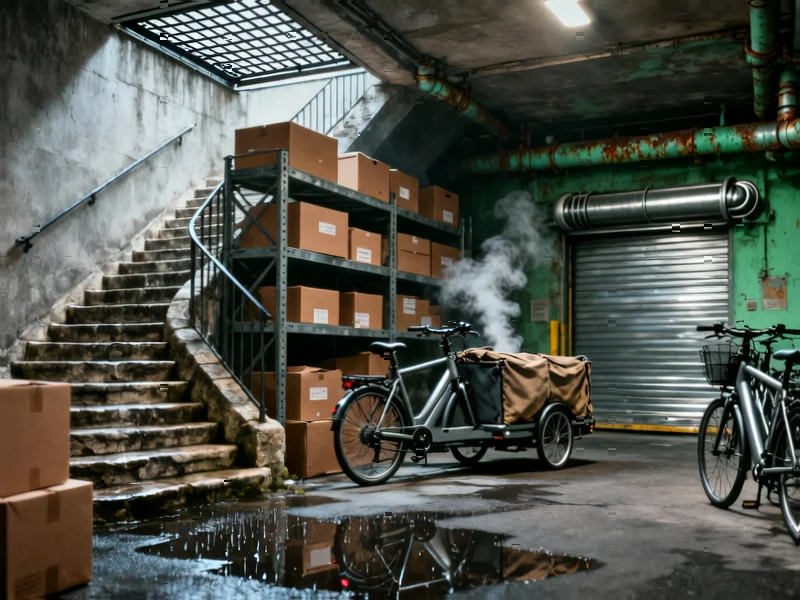According to Bloomberg Business, beneath the bustling Champs-Élysées in Paris, a former parking garage is being transformed into an underground retail warehouse called Atelier Logistique that will serve approximately 4,400 nearby retail stores using cargo bikes instead of traditional delivery trucks. The initiative comes as part of Mayor Anne Hidalgo’s broader efforts to reduce vehicle traffic and pollution in the congested city, with studies showing delivery vehicles account for 15-25% of urban vehicle miles traveled while comprising up to 40% of road space and CO2 emissions. The strategic location enables efficient last-mile distribution through zero-emission cargo bikes rather than gas-powered trucks that typically congest the famous shopping district. This innovative approach represents a growing trend of urban logistics hubs emerging in dense city centers to combat pollution while maintaining commercial efficiency.
Table of Contents
The Urban Logistics Revolution
What Paris is implementing represents a fundamental shift in how cities approach retail logistics in dense urban environments. Traditional delivery models rely on large trucks making multiple stops throughout city centers, creating what transportation planners call the “last-mile problem” – the most inefficient and environmentally damaging segment of the supply chain. The underground warehouse concept essentially brings the distribution center closer to the final destination, enabling smaller, cleaner vehicles to handle the final delivery leg. This isn’t just about reducing emissions – it’s about reclaiming valuable urban space currently dominated by double-parked delivery trucks and loading zones that disrupt traffic flow and pedestrian mobility.
The Cargo Bike’s Silent Revolution
The choice of cargo bikes for final deliveries represents a sophisticated understanding of urban dynamics that many cities overlook. Modern electric cargo bikes can carry surprisingly substantial loads – typically 200-400 kilograms – while occupying a fraction of the space of delivery trucks. They navigate narrow streets more efficiently, don’t contribute to traffic congestion, and can access areas restricted to larger vehicles. More importantly, they operate silently and produce zero local emissions, making them ideal for early morning or late-night deliveries when retail restocking typically occurs. The psychological impact shouldn’t be underestimated either – replacing noisy, polluting trucks with quiet, human-scale vehicles fundamentally changes the urban experience for residents and visitors alike.
Paris’s Broader Transportation Vision
This initiative fits within Paris‘s ambitious multi-year plan to transform urban mobility under Mayor Hidalgo’s leadership. The city has been systematically reducing space for private vehicles while expanding pedestrian zones, bike lanes, and public transportation. The Champs-Élysées itself is undergoing a major transformation to become more pedestrian-friendly, with plans to reduce vehicle lanes and create more green spaces. The underground warehouse represents the logical extension of this philosophy into commercial logistics – if you’re going to restrict vehicle access, you need to provide alternative systems for essential services like retail deliveries. This holistic approach distinguishes Paris from cities that implement piecemeal transportation policies without considering the interconnected nature of urban systems.
Implementation Challenges Ahead
The concept faces several significant challenges that will determine its long-term success. Underground facilities typically have higher operating costs due to ventilation, security, and accessibility requirements. The limited capacity of cargo bikes means more frequent deliveries might be necessary, potentially increasing labor costs. There’s also the question of scalability – while serving 4,400 stores sounds impressive, Paris has over 100,000 retail establishments, suggesting this model would need significant replication to make a meaningful citywide impact. Perhaps most importantly, the system requires sophisticated inventory management and coordination among competing retailers who must share infrastructure, which presents both technical and competitive challenges that don’t exist in traditional delivery models.
Global Implications for Urban Planning
If successful, Paris’s underground warehouse could become a blueprint for cities worldwide grappling with similar congestion and pollution challenges. Cities like London, New York, and Tokyo all face the fundamental contradiction of wanting to reduce vehicle traffic while maintaining vibrant commercial districts. The Paris model offers a potential solution that doesn’t require sacrificing economic activity for environmental goals. We’re likely to see more cities repurposing underground spaces – from disused subway tunnels to parking garages – for similar logistics hubs. The key innovation isn’t the technology itself, but the spatial rethinking of how cities organize essential services in an era of climate consciousness and urban density.
The success of this initiative will depend on whether the operational efficiencies can offset the higher infrastructure costs, and whether retailers will embrace the collaborative model necessary to make shared urban logistics work at scale.



